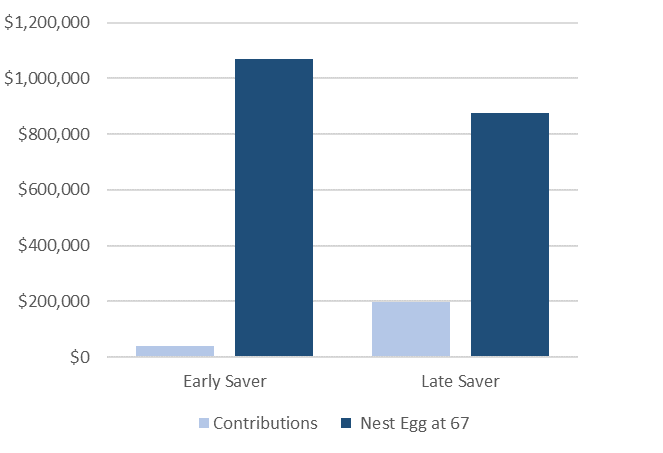Where Should You Save For College?
February 06, 2025The long-term trend is that college costs have increased at nearly twice the inflation rate. That’s astounding!
That rising cost factor contributes to an enormous and ever-growing student loan debt. It now totals over $1.7 trillion in the U.S. That number continues to grow each year and is an alarming trend.
What’s driving these costs? Competing for students by hiring top faculty, building and maintaining facilities and ever-nicer amenities, greatly increasing non-teaching staff positions, and a transfer of financial responsibility from government subsidies to the students and their families are all factors increasing the cost of attending college. For someone facing this burden in the future, the question of “Where should I save for college?” is a very common one. There are a lot of choices out there and I’ll walk through the pros and cons of a few.
UGMA/UTMA (Uniform Gift (or Transfer) to Minors Act):
- This is a very common way that parents open accounts for young children to collect birthday checks and random other funds that the child receives and where my son’s paychecks from his first job are currently being deposited. The best part of this type of account is that many financial institutions in the country offer these and your investment options are almost unlimited.
- The downside of the UGMA/UTMA is that at the child’s age of majority (between 18 and 21 depending on the state), the assets become the property of the child so if they see a shiny new car or motorcycle or guitar that they want to buy…they can do that rather than pay tuition. Also, significant assets in the child’s name have the ability to negatively impact a financial aid package.
529 savings plan
- Typically, when I talk to people and they say they want to open a college funding account, they are talking about a 529 savings plan. (My favorite college planning website www.savingforcollege.com started out as a 529 plan review website and has built other capabilities over the course of time.) 529 plans can offer a state tax break for dollars on the way into the plan, growth that is tax deferred, and if used for education, a nice tax break on the way out. They are a GREAT way for grandparents and other relatives to contribute to the cost of education. When my daughter was very young, I set up a 529 and let all her grandparents, aunts, uncles, etc. know that it existed and suggested that rather than buy a toy that might end up at a yard sale in 18 months, throw a few dollars into the 529. Surprisingly, they listened! She isn’t going to be able to fund college with birthday/Christmas gift money, but it’s paying for books and we are happy that she has that plan in place.
- The downside of the 529 is that investment options are quite limited and while it’s technically an asset of the parent on the FAFSA form, many schools consider it an asset of the child and can alter the financial aid package accordingly. To combat this, I’ve seen grandparents or a non-custodial parent open the 529 so that it avoids being reported on the FAFSA form. Just be aware that withdrawals from non-parental 529 accounts can be considered income to the child, which has an even greater impact on financial aid eligibility, so you might want to wait until the last couple years of school to tap those savings.
Prepaid 529 plan
- The prepaid plans are far less common than the traditional 529 above, but where they are available, they can be very attractive options. The way these usually work is that you buy a number of credit hours today at current prices and when the child goes to college, those credit hours are already paid for. The rate of return on the investment equals the rate of tuition increase, which has been staggering over the last 20-30 years. If the child goes to school in another state or at a private university, the funds on deposit cover the average cost of attendance that year at a state public school so there is a nice “bang for the buck” historically since the costs have risen so quickly.
- The primary downside of prepaid plans is that since they’ve been so good for the investor, many states have frozen or terminated their plans. At a time when many states are struggling to pay the bills (trying not to go on a rant about budgetary restraint here), giving investors a very hefty return on their money puts added strain on a budget.
Taxable account in parent’s name
- Opening an account in a parent’s name is one of my favorite ways to see education funded. It has a far less harmful effect on financial aid and if the funds aren’t used for education, they are there for retirement or debt reduction or a really awesome vacation! The universe of investments is unlimited and the control of the assets remains with the parent. If there was one place I wish I had spent more time focusing on for my kids’ education, it would be here.
Retirement account
- Retirement accounts are an area that people are widely using to fund education costs now. From a FAFSA standpoint, these are favored assets since they don’t cause the EFC (expected family contribution) to rise (although withdrawals generally do have an impact since they are counted as income). But the funds are available, either through a loan or a hardship withdrawal from a 401(k) or a penalty-free withdrawal of principle from a Roth IRA to fund a portion of education expenses. It’s a ready pool of assets that can be tapped when other resources might not be available.
- The downside of using a retirement account as an education funding vehicle is that every dollar removed is a dollar that isn’t available for retirement. Are you willing to risk having fewer retirement dollars, especially in an era where downsizing, layoffs and an uncertain future (gone are the 40 years and a gold watch at retirement employment situations) are the new normal. This seems like a good short term option for many, but the risks are high. This is a “tread with caution” type of way to fund college costs.
Equity in your home
- During the housing boom that ended in 2008, a lot of people used the quickly building equity in their homes to fund college. Today, post-housing bust, that isn’t as common but for those who have been in their homes for a long time and have significant equity, this is still a “go-to” strategy. As someone who is wired to be debt-averse, I’d like to point out that if you pay your mortgage down with additional principal payments and your child gets a full scholarship, I’ve never heard anyone complain about owning their home free and clear. It sure makes retirement easier since cash outflows are easily handled.
- Much like the downside of using your 401(k), using equity in your home to pay for college could have you paying a mortgage well into retirement, which could mean a reduced standard of living post-retirement or working a few extra years to pay down that debt.
If you are looking for “the best way” to invest for future education expenses, I can’t say that any one of these options is the absolute best in every situation. What can you afford to do today? Do you want to factor in the financial aid impact of your investment strategy, or is your income high enough to make financial aid a moot point? Do you want an investment that can be used for your goals if your child gets scholarships or opts for a non-college career path? Look at each option’s pros and cons to determine the most suitable choice for your family.


